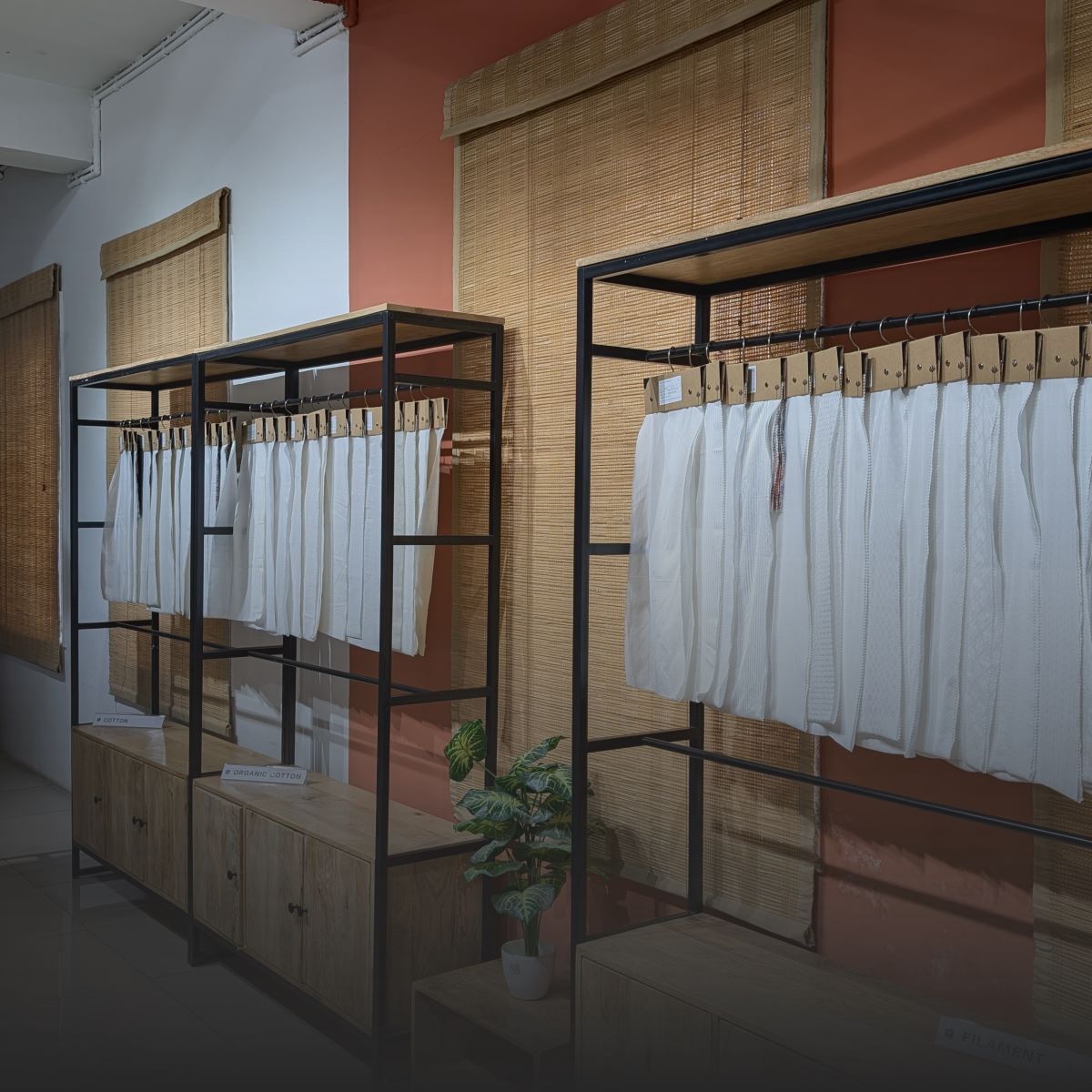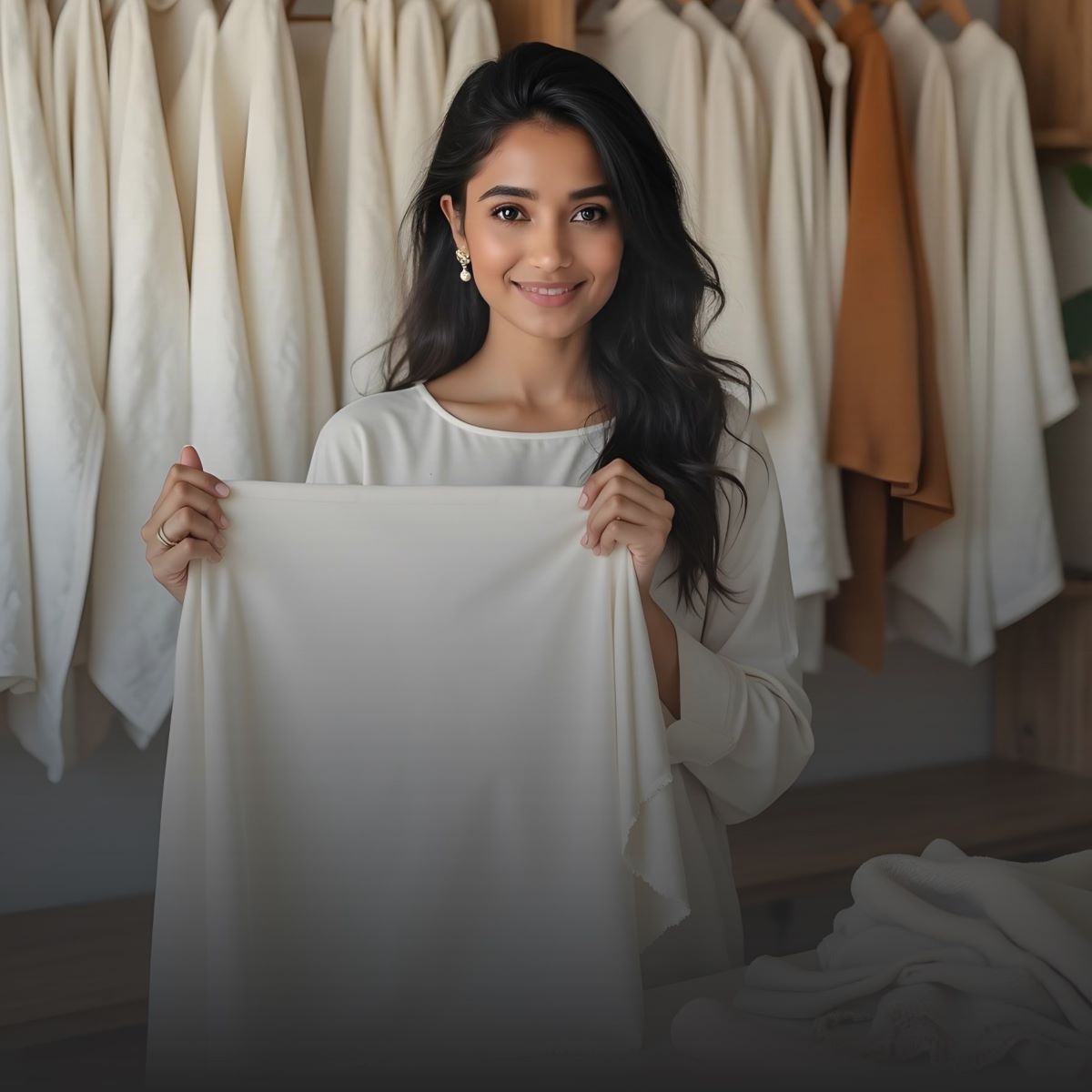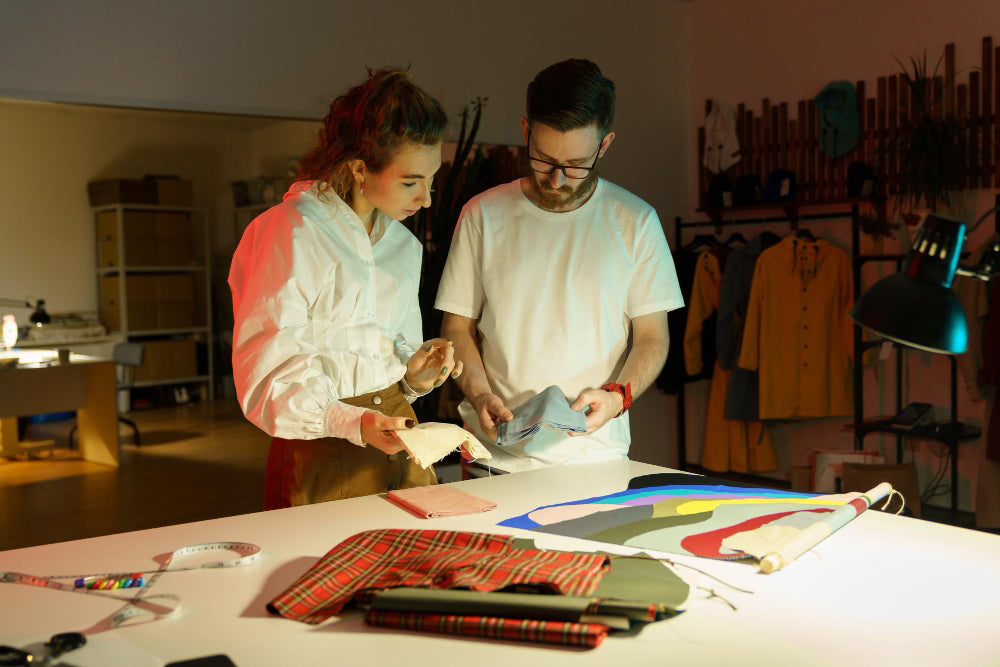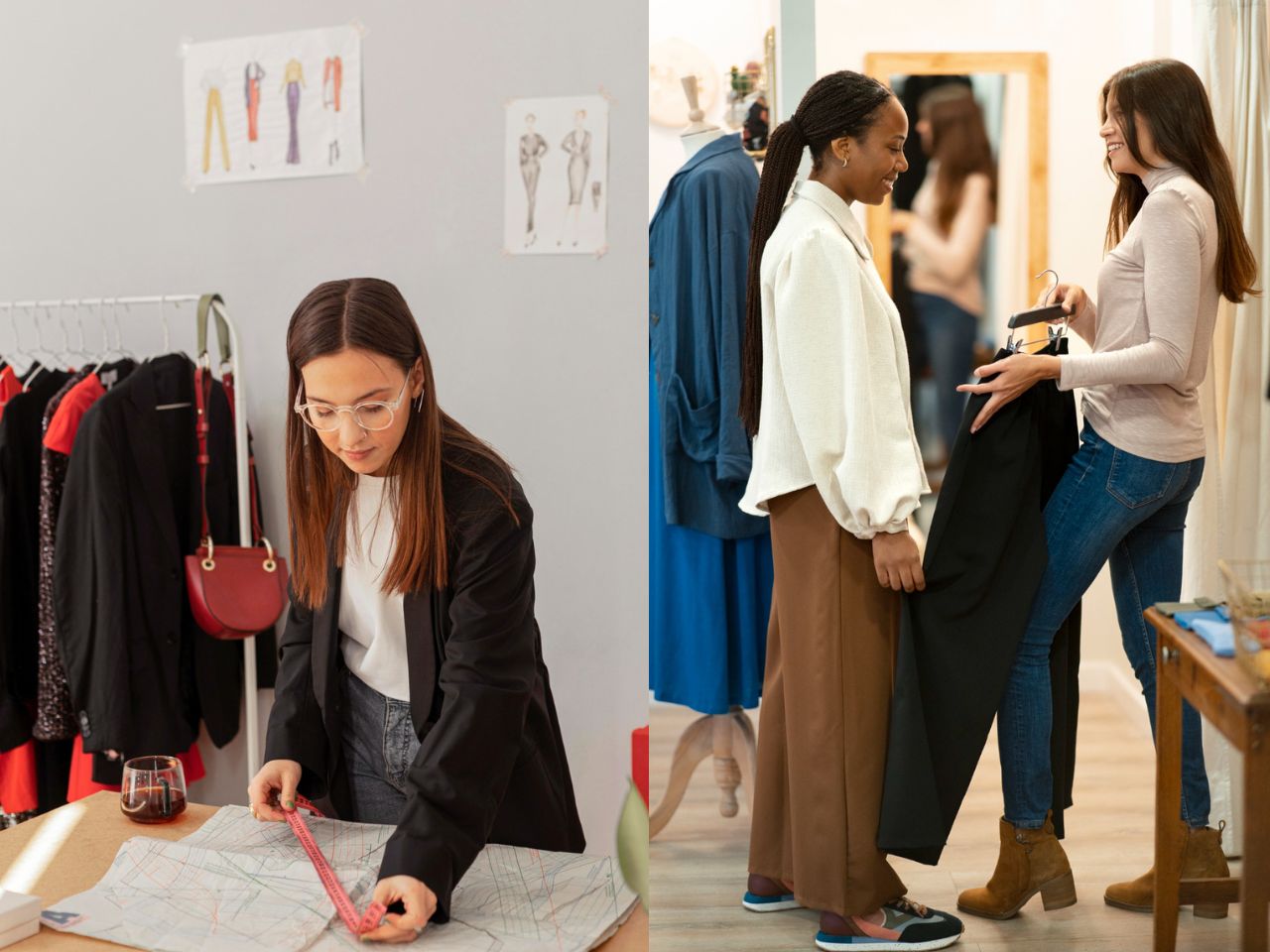Today's oversaturated fashion market requires more than bold cuts and trendy colours to distinguish. The real differentiator? Fabric. International designers increasingly emphasize custom fabric as their brand hallmark, incorporating storytelling, sustainability, and technical innovation. Custom textiles are helping designers create attractive, distinctive, and meaningful brands throughout Europe, Asia, and Africa. The good news? This method is not exclusive to the elite. Even U.S. fashion startups and indie companies can use this strong tool to stand out. Learn why custom fabric is crucial and how foreign designers are using it to stand out in the article below. The major duty of a wholesale fabric supplier in the USA is overall.
The Power Of Customization In Modern Fashion

Customization is a tendency towards sustainability, exclusivity, and storytelling. Designers are replacing mass-produced textiles with bespoke fabrics that reflect their brand's values as consumers seek authenticity and originality.
Custom fabrics let foreign designers manage patterns, textures, and materials, allowing them to realize their concepts in ways ready-made solutions cannot.
- Originality on Demand: Custom fabrics give designers' collections a unique look with designs, textures, and colours.
- Adaptability to Trends: By creating textures or materials for eco-friendly or streetwear clothes, designers may quickly respond to seasonal trends.
- Sustainability: As ethical production becomes more important, designers pick organic cotton or Tencel textiles that match their brand.
- Technology Integration: Innovative dyeing and digital printing methods provide fast, high-quality fabric customization.
Why Custom Fabrics Are Game-Changers

- Exclusive Designs = Unmatched Appeal: Designers collaborate with wholesale fabric manufacturers usa to develop distinctive fabrics. Think about a design that draws inspiration from nature, culture, or abstract art, aligning seamlessly with the brand's message.
- Sustainability with a Twist: Numerous designers are incorporating eco-friendly, custom-dyed materials to harmonize style with sustainability in response to the rise of mindful consumerism.
- Personalized Aesthetics: Designers can test textures, colours, and finishes with custom fabrics. Imagine hand-painted silks, digitally printed cotton, or embellished denim.
Why Fabric Is Your Fashion Brand's Secret Superpower

To make your clothing brand stand out, focus on the fabric, which is the core of fashion. Custom fabric is being used by international designers to improve their brands. Let's dive in and learn how you can do the same;
The Rise Of Custom Fabrics In Global Fashion
Custom fabric is changing brand design, production, and communication. Designers are using narrative textiles to add uniqueness, personalization, and impact.
Why Customization Matters More Than Ever
Customization is no longer a nice-to-have; it's a must for business. In a world where everything is the same off the shelf, custom fabrics let brands make something unique, from textures and designs that make people feel something that isn't available anywhere else. These materials, like digitally printed silks or hand-dyed cotton, show off a designer's idea in the most straightforward way possible.
From Mass Market to Signature Materials
There is a lot of mass sameness because most fashion brands buy from the same mills and suppliers. That's not true for custom fabrics. When you come up with your weaves, colours, and finishes, you can make easily recognizable clothes that are hard for others to copy.
When creating a fashion label, remember that fabric is not just a canvas—it’s the essence of your brand's identity.
Fabric As The Foundation Of Brand Identity

Fabric choice is a big part of what makes a brand unique. It's not enough to make something look and feel good; it has to send a message and tell a story that fits the brand's values and goals.
Using Textiles To Tell A Story
Clothing can express a brand's history and mission. By using materials with cultural, historical or personal characteristics, designers can create clothing that conveys a lot without speaking. This storytelling technique gives depth and authenticity to the brand, making it more relatable and memorable.
Case Study: Sindiso Khumalo and Cultural Narratives
South African designer Sindiso Khumalo has established a business on custom sustainable fabrics and African narrative. Her hand-drawn prints are influenced by South African history and women's emancipation. And her stuff? Local artisans and communities benefit from ethically produced natural fibres.
The message in each fabric—not simply the silhouettes—makes her work memorable. Her outfits not only fit but also speak.
Exclusive Textiles Enhance Competitiveness
Exclusive fabrics may set you apart in a competitive sector. Brands entice consumers seeking novelty and quality with their distinct selling proposition.
Schiaparelli, Chanel, And Heritage Mill Strategies
Luxury brands like Schiaparelli and Chanel have traditionally valued distinctive materials. Heritage mills and craftspeople help these brands create distinctive fabrics that define their identity. This provides high-quality materials and reinforces the brand's craftsmanship and legacy.
Making Unique Weaves And Finishes
Custom weaves and finishes can help brands stand out from the competition. The brand's market position and appeal are both improved as a result of the use of distinct textures, patterns, and sheens that are customised to the brand. This one-of-a-kind quality makes it more difficult for rivals to replicate, thereby preserving the exclusive nature of the brand.
Personalisation In Print And Pattern

More and more people want colours and patterns that aren't found anywhere else. This lets companies cater to specific tastes. This customisation makes customers more interested and happy.
Customised Fabrics For Unique Customer Connections
With made-to-order materials, businesses can make unique things that customers love. This method meets the rising need for customised experiences and makes the connection between the brand and the customer stronger. Putting customers into patterns is a way for brands to get them to stick with them.
Custom Colourways & Limited Editions
Exclusive colourways and limited-edition designs encourage shoppers to act swiftly and feel special about their purchase. This method promotes sales and boosts the brand's innovative, customer-focused reputation.
Combining Craft And Technology
Fashion designers use textiles differently as time goes on. International labels are combining traditional craftsmanship with current technologies to innovate textile design and manufacture.
Fabric Manipulation, Dyeing, And Digital Printing
Digital textile printing expands design freedom. It prints complex, photo-realistic designs on fabric quickly and with little waste. Designers increasingly use ombré gradients, plant-based colours, and tie-dye reinventions to produce contemporary, textured finishes.
Ruching, smocking, pleating, and quilting are no longer couture. These methods are currently used by independent designers to give clothes structure and sculptural features. Brands produce modern, handmade materials by combining heritage abilities with digital convenience.
Modern Fashion Techniques Advance
Global top designers are redefining “fashion as clothing” as “fashion as experience.” This combines traditional craftsmanship with high-tech methods like:
- Foil and reflective printing
- Textiles that change colour with heat
- Metallized or repurposed fabrics
Simone Rocha, Sacai, and Craig Green are reimagining fabric by blending old-world weaving with tech-based treatments. More than clothes—these are discussions.
How Sustainability Shapes Fabric Choices

Materials are now chosen based on environmental impact. Sustainable textiles that encourage ethical production and resource stewardship are being sourced and customised by international designers.
Eco-Friendly Fibers Like Tencel, Hemp, and Banana Silk
Designers are using "Tencel" for its softness and low water use and hemp for its durability and environmental impact. New textiles like “banana silk” and “bamboo rayon” are popular for their sustainability and beauty.
Sustainable choices are commercial and good for the earth. “Gen Z” and “Millennial” shoppers want transparency and accountability. Promoting eco-friendly bespoke materials improves brand trust.
Designers Leading the Sustainability Movement
Global businesses like Stella McCartney show that eco-friendly doesn't mean boring. Biodegradable and repurposed materials are used in exclusive prints in her collections. BODE in the U.S. makes luxury clothing from antique and deadstock fabrics, emphasising sustainability.
Strategic branding with tailored sustainable textiles is possible for fashion entrepreneurs. Their uniqueness aligns your business with modern principles.
Leveraging AI and Data in Fabric Design
AI is changing how designers predict trends, test fabric ideas, and personalise fabrics. Algorithms and consumer data help speed up intuition and mood boarding.
Predictive Trends and Personalized Textiles
AI algorithms forecast colour, fabric, and texture trends by analysing massive volumes of consumer behaviour, online searches, and social chatter. This keeps designers ahead. If AI predicts increased demand for pastel-toned loungewear, manufacturers can design unique materials to meet that need, ensuring innovation and commercial viability.
Fabric Forecasting with Machine Learning
Machine learning also helps producers and designers predict cloth behaviour under different treatments or blends. This decreases sampling waste and improves first-try success.
AI-integrated systems like Midjourney or Runway ML can inspire new fabric images for fashion startups, while trend tools like WGSN or Edited help you plan wisely. Let tech enhance your creativity.
The Advantage Of Low MOQ In Customization
Custom fabric access is changing due to low MOQs. Small brands can now try distinctive materials without mass production.
Small-Batch Possibilities for Startups
Due to cost and scale, custom fabric printing was long reserved for huge fashion businesses. Digital printing and on-demand customization allow entrepreneurs to try novel patterns or textures with 10 yards.
Brands may launch capsule collections, seasonal experimentation, and artist collaborations without overstocking. It promotes agility and inventiveness, notably in fast-to-market e-commerce.
Platforms Enabling Entry-Level Fabric Innovation
The following are examples of some of the most reputable platforms and manufacturers who provide small-batch custom services:
- Spoonflower – for DIY designers looking to test patterns.
- Fabriclore –One of the major "fabric wholesale suppliers usa" provides digital printing services, artisanal textiles, and full sourcing support.
- Contrado – UK-based print-on-demand fabric platform.
- Hemp Fortex – for sustainable, certified hemp-based textiles
When you team up with these partners, you can keep your creativity flowing without worrying about budget or scale. All you have to do is kick things off in a smart way.
Innovation Beyond Aesthetics: Functional Fabrics
Fabric functionality is now commonplace. Many fashion lines feature performance textiles for protection, comfort, or adaptability.
Performance Textiles (Smart, Antimicrobial, Temperature-Regulating)
Consumers value performance textiles like moisture-wicking, odour-resistant, UV-blocking, and heat-adaptive fabrics. Stone Island and Nike ACG create bright fabric lines that meet user needs.
Designers are adding cooling characteristics to loungewear, officewear with stretch and breathability, and wrinkle-resistant travel clothes.
Sensory Fabrics For Enhanced Customer Experience
Clothing is about texture, softness, and feel. Designers use brushed finishes, raised knits, and layered mesh to improve comfort and touch. Sensory design evokes emotion and loyalty.
One unique functional fabric might make your startup stand out. Your collection's feel and sales depend on the material, whether a smooth knit or breathable hemp blend.
Artistic Collaborations And Fabric As Canvas
With personalized materials, fashion and art are merging more than ever. Designers collaborate with illustrators and visual artists to create unique, story-driven prints.
Partnerships with Illustrators and Artists
These collaborations lead to unique fabrics—each collection has its distinct look. Imagine bold brushstrokes, personal stories, or patterns inspired by culture, all seamlessly integrated into the fabric. It's such a terrific way to blend visual storytelling with wearable design.
Creating Collectible Fashion Pieces
Your brand becomes more desirable and exclusive when limited-run fabrics become collector's items. Startups may boost brand awareness and sell “first edition" products with just one relationship.
Tradition Meets Modernity In Textile Design
The combination of traditional design practices with contemporary design has emerged as a potent strategy for designers all over the world.
Fusion Of Heritage Craft With Contemporary Techniques
One of the finest 2020s design trends is the blend of traditional textile techniques with modern fashion sensibilities. Not repeating history, but redefining it.
Designers worldwide are incorporating old fabric crafts into their styles. Indian brands adopt modern styles and Ajrakh block printing or Khadi hand-spun cotton. Shibori dyeing meets futuristic tailoring in Japan. UK designers like Simone Rocha employ Irish lace, transparent synthetics, and sculpted forms.
This fusion adds design depth. Not only does the fabric look cool—it has history. That is important to current consumers seeking authenticity and connection. The apparel feels meaningful, not mass-produced.
Global Examples From Japan, India, And The Uk
- Sacai (Japan): Brings together old and new styles by combining military leftovers with fine knits and digitally layered prints.
- Rahul Mishra (India): Brings needlework made by craftspeople in the countryside to Paris Fashion Week in a way that is new and different.
- Wales Bonner (UK): Handwoven fabric and poetic stories are used to bring Afro-Caribbean history into menswear.
- Aurora James – Brother Vellies (USA): Brother Vellies, founded by Aurora James in New York, blends African and Indigenous craftsmanship with modern design. Traditional weaving, vegetable-tanned leather, and hand-dyed materials from artisan communities offer her creations a cultural grounding while appealing to high-fashion.
As a company, consider using your heritage or community's craft traditions. Custom textiles let you dress for the past and the future.
Building Brand Loyalty Through Custom Textiles
Custom materials help businesses connect with customers on a more emotional level.
Emotional Engagement Via Unique Materials
Think about your favorite fashion pieces. It’s not just the fit—it’s the feel. It’s the story. Fabric has a direct emotional impact, and that’s why using custom textiles is such a powerful way to build brand loyalty.
Consumers today aren’t loyal to labels—they’re loyal to experiences. When a brand tells them where a fabric came from, how it was made, and what makes it different, they’re more likely to connect and come back. Here’s what emotional branding through fabric looks like:
- Sharing a short video of artisans weaving your textile.
- Printing crafted with desert-grown cotton from Rajasthan on a product tag.
- Naming your print after a personal memory, poem, or place.
It’s about tapping into emotion. When people feel something, they remember—and recommend.
Long-Term Value And Brand Differentiation
Custom materials boost your brand identity over time. Consider textiles your visual DNA. These develop your signature over multiple collections.
So labels like Missoni with its zigzag knits and Burberry with its plaid have become icons. They made brand architecture from fabric.
Long-term thinking is important even when starting. Create season-long prints, textures, and colourways. Customers will recognise you when they see those again.
Tech Platforms Driving Fabric Customization
Thanks to technology, custom fabrics are now available to everyone, not just the big brands.
Spoonflower, Printful, And On-Demand Digital Solutions
Spoonflower, Printful, and Contrado offer “on-demand digital printing” with minimal minimums. Designers can upload a print and receive high-resolution cotton, silk, or jersey fabric within days. Sample books and dropshipping integration with Shopify and Etsy are available on these platforms.
Fabriclore is the best choice for bigger runs because it offers "on-demand digital printing with a low MOQ of just 100 meters." It's great for designers who want to keep quality and customisation at the centre of their work while also ready to grow.
These tools enable designing, printing, and shipping your own trademark fabrics waste-free and on your terms easier than ever, whether you're testing new prints or launching limited-edition drops.
Integrating AI Tools Like Midjourney For Textile Ideas
AI design tools like Midjourney, DALL·E, and Runway ML are influencing new textile concepts beyond printing. Design suggestions like "botanical goth florals" and "sci-fi tribal textile" are inspiring dozens of moodboards. Use these images to: -
- Inspire fresh print designs
- Create capsule collection themes
- Prepare social media teasers before launch.
New drawing is faster, cheaper, and more visually appealing. The best part? Nobody else has your creation.
Turning Custom Fabrics Into Intellectual Property
Fabric can be your brand's most important asset, not merely a design feature. When carefully designed, unique materials become IP that protects and enhances your fashion business.
Original Prints As Protection Against Fast Fashion Copying
Copying designs is a major issue in fashion, especially when quick fashion retailers do it in weeks. However, custom-made fabric is better.
Special prints or fabrication methods make custom fabrics intellectual property. They're tougher to replicate and riskier to steal. Big brands know. Therefore, Etro, Dries Van Noten, and Marimekko invest in exclusive prints. While the cut can be copied, the fabric is untouchable.
Startups' invisible armour. Register your prints for copyright. Encrypt digital designs. Only use reliable vendors who won't leak ideas.
Building A Fabric Library For Brand Longevity
Make sure to keep an eye on every print, weave, and finish you come up with. As time goes on, these can turn into valuable assets that you can bring back, give new life to, or save as key parts of your brand.
Practical Takeaways For USA Fashion Startups

These tips can help you make the most of your design work with the least amount of risk, whether you're in New York, Los Angeles, Chicago, or Miami:
- Start Smart: Utilise platforms such as Fabriclore, Printful, or Spoonflower to experiment with prints in limited quantities.
- Tell Your Story: Explain the process behind your fabric production—people appreciate openness.
- Collaborate Widely: Team up with artists or international mills to gain new, cultural insights.
- Be Sustainable: Select sustainable fabrics that resonate with consumer principles.
- Use Tech Tools: Utilise AI and digital printing to remain fashionable and economical.
- Keep MOQ Low: Work together with textile suppliers that prioritise small-scale production, such as Fabriclore.
- Fuse Old & New: Combine classic craftsmanship with contemporary shapes for a remarkable collection.
These tips can help you scale, be adaptable, and build a unique brand.
How Fabriclore Supports Designers on Their Customization Journey

Fabriclore empowers designers and small brands by making custom fabrics available, affordable, and real. Fabriclore, a reputed fabric supplier for small businesses, provides a whole fabric experience rather than just products.
- Low MOQs: Start your unique journey with 100 metres per design for testing new concepts.
- High-Quality, Authentic Fabrics: Our materials, including organic cotton and BEMBERG™ and LENZING™ blends, are carefully selected and quality-checked.
- Advanced Printing Options: Choose digital, screen, or hand block printing to realise your concept.
- Artisan Collaborations: Our chosen artisan network combines current fashion with Indian craftsmanship.
- Experience Studio: Before ordering, visit our Online Fabric Experience Studio' or watch the fabric video to understand texture, fall and colour.
You're not simply buying fabric with Fabriclore—you're constructing a story with a platform that understands new designers and fashion entrepreneurs.
Final Thoughts
Fabric is more than just a base in today's fashion world; it's a statement. Custom textiles let designers tell essential stories, care about the environment, and stand out in a crowded market. Low MOQs, digital printing, and relationships with artisans make innovation possible for everyone, from big brands to new businesses in your town. Fabric, as an artistic tool, is not just a commodity; it is what future brands will use. So, don't just think about shapes; think about the textures and materials telling your brand's truth. When you use the right fabric, you don't just make clothes but shape events. Are you ready to make things better? Fibres are the first step.
FAQs
1. What Are Custom Fabrics, And How Do They Benefit New Fashion Brands?
Custom fabrics are textiles developed with unique patterns, weaves, prints, or treatments designed to meet a designer's specifications. For startups, they assist in defining brand identity, providing uniqueness, and fostering emotional engagement with customers—an outcome that off-the-shelf fabrics seldom accomplish.
2. Can Small Fashion Startups Afford Custom Textiles?
Spoonflower, Printful, and Fabriclore allow small firms to experiment with custom fabrics in small numbers at minimal cost. No longer must 1,000 yards be ordered to test a concept.
3. How Do Custom Fabrics Contribute To Sustainability Goals?
Custom fabric development lets firms use hemp, organic cotton, or Tencel, save waste with digital printing, and produce only what they need. It promotes slow fashion and eco-consciousness.
4. What Technology Is Used To Create Custom Fabrics?
The custom fabric industry uses digital textile printing, AI-generated pattern design, laser cutting, 3D fabric simulation, and machine learning for trend prediction. They boost innovation, speed, and waste reduction.
5. Where Can Fashion Startups Source Small-Batch Custom Fabrics?
Startups can look into buying through sites like
- Fabriclore: Hand-picked craft and eco-friendly fabrics with printing options
- Spoonflower: Let U.S. artists print custom items whenever they want.
- Printful and Contrado: Offer worldwide drop-shipping and printing services for fabrics
- Hemp Fortex: Eco-textiles that have been certified for environmentally friendly brands





Leave a comment
This site is protected by hCaptcha and the hCaptcha Privacy Policy and Terms of Service apply.